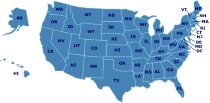Manipulatives
The use of manipulatives are a creative and fun way to introduce and reinforce learning, especially in the area of mathematics.
Resources
Bead Sequencing Set
Stack the durable, brightly colored wooden beads on 5 hardwood dowels in sequence to match the design on one of the pattern cards. Builds complex reasoning skills as well as sorting and coordination. Includes over 45 brilliantly colored beads, 5 dowels, and 10 patterns that increase in difficulty.
Idea Book For Cuisenaire Rods At The Intermediate Level
Grades 2-5. Idea Book designed for use with Cuisenaire Rods.
Cuisenaire Rods Multi-Pack
Grades Pre K & up. An economical way to bring rods into the classroom. Pack contains six sets of 74 rods, six trays with, and Teacher's Guide. For use with 12-18 students.
Flip Over Math Manipulatives
Grades 1-5. Tub of over 500 manipulatives includes Pattern Blocks, Connecting People, Cuisenaire Rods, Coins, and Bean Counters and can be used with the Flip Over Math Books. This 49 page book (others sold separately) is written to NCTM Standards and provide hands on activities from basic math skills to advanced problem solving.
Idea Book For Cuisenaire Rods At The Primary Level
Grades K-4. Each 120 page book contains worksheets and has selected activities that cover the major math standards. Each page outlines the grade level, materials needed, settings, learning experiences, and are based on NCTM Standards.
Pattern Blocks and Boards
This set of 10 simply designed colorful wooden blocks and pattern boards includes 100 blocks in six different shapes and colors. They help develop shape recognition and spatial relationship skills. The contents store neatly in a durable wooden case. This games was awarded the Scholastic Parent & Child's 2004 "Top 22 Toys that Make Kids Think" award.
Using Manipulatives in Your Homeschool
How to Make the Most of Math Manipulatives
Marilyn Burns discusses creative and effective ways to use manipulatives to teach math. Much of her information is oriented towards classroom instruction, but there is great information for homeschoolers too. She discusses the seven "musts" for using manipulatives, how to introduce a Geoboard, pattern block activities, and more.
Math-U-See Users Group
This email group is for lovers and users of the Math-U-See program.
5 DIY Manipulatives for Preschool and Kindergarten
These manipulatives are easy to make at home. They provide early learning supplies for anyone on a budget.
Virtual Manipulatives for Interactive Mathematics
This website features online games and interactive activities designed to help children learn and understand mathematical concepts. You can choose any grade level from pre-K to 12, and subjects including numbers and operations, algebra, geometry, measurements, data analysis, and probability. You'll find virtual peg boards, geoboards, fractals, charts, games, and much more.
Featured Resources
As an Amazon Associate, we earn from qualifying purchases. We get commissions for purchases made through links on this site.
The Outdoor Life of Children: The Importance of Nature Study and Outside Activities (Charlotte Mason Topics - Volume 2
The methods of Charlotte Mason are popular among homeschoolers. She includes nature study as a crucial element. This work explores the idea of the outdoors as a classroom for children, and gives tips on ways of teaching the sciences, history, literature, music, and art through the use of outdoor space.
First Language Lessons for the Well-Trained Mind
Includes scripted lessons and lovely illustrations to offer encouragement and understanding to children in grammar, copywork, narration, picture study, and other classical technique. These lessons will help develop the student's language ability and skills in oral composition.
Learning Styles: Reaching Everyone God Gave You to Teach
This book offers helpful and practical strategies about the different ways that kids acquire information and learn, and then use that knowledge. Kids' behavior is often tied to a particular learning style and understanding that fact will help parents respond to their child in ways that decrease frustration and increase success, especially in a homeschooling environment.
The Unprocessed Child: Living Without School
This book shows how school is not necessary for a child to gain learning, socialization, or motivation. It offers a look at radical unschooling, a way of educating children without coercion, curriculum, or control. This look at a child who grows from childhood to adulthood with the experience of self-direction is a celebration of the success of unschooling. Covers topics such as parenting, self-discipline and self-motivation, socialization, and more.
A Catholic Homeschool Treasury: Nurturing Children's Love for Learning
This book reviews different approaches to learning and different homeschooling methods. Read parents' perspectives and learn more about homeschooling issues.











